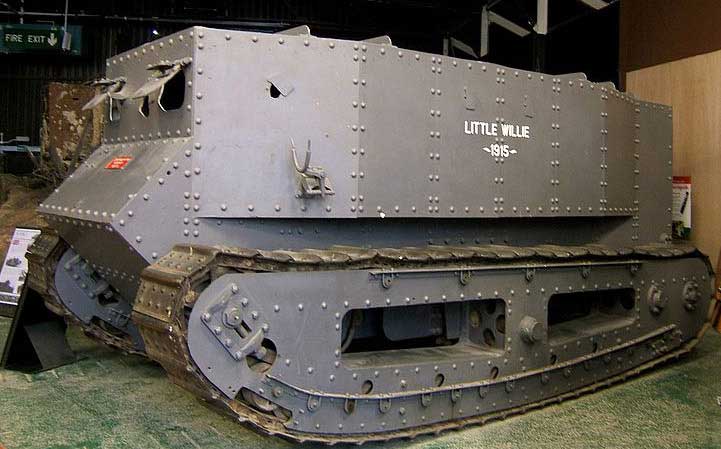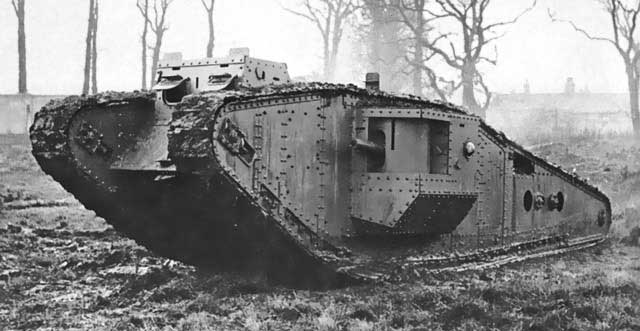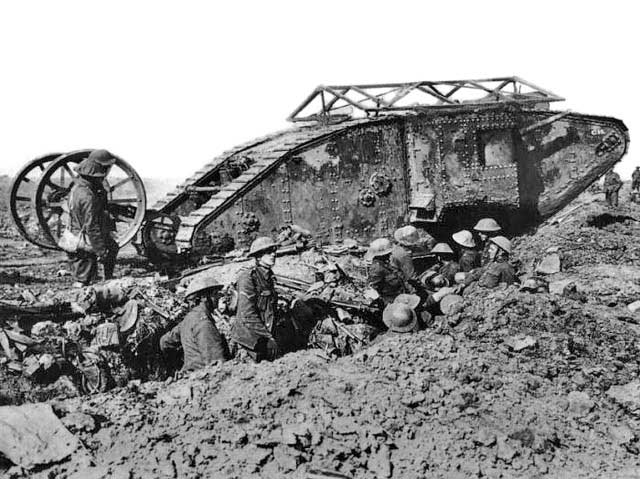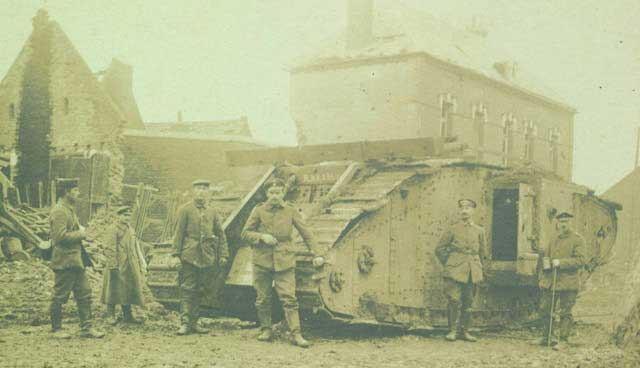The stalemate on the Western Front in 1915 led some Brits to thinking that things weren't working out. Non-bullet proof men charging over hundreds of yards of No Man's Land against machine guns was not fulfilling the top brass's ambitions, but they were still notoriously inflexible when it came to new technologies.

The guy responsible for getting tanks into warfare was then Major Ernest Swinton, later to become Major General, a military reporter on the Western Front. He saw how the Holt gun tractor was about the only machine capable of moving around the mud and carrying heavy loads, and realized suddenly that an armored and armed gun tractor could be of use. Lord Kitchner refused to entertain the idea, but Winston Churchill got wind of it, and as First Lord of the Admiralty went behind the army's back and formed the Landships Committee to see what could come of the idea. In an odd twist, the Royal Navy was about the only service with experience in armoring things, and shooting cannons from enclosed spaces, so designing the first tank was dropped in their lap. The Mark 1 was the most successful tank design of the war. By 1916, Swinton was promoted to Lieutenant Colonel, and was heavily involved in tank crew training,
British Mk. IV tanks in action from Australian War Memorial
The Holt Company was initially considered to build the first tanks, but they were already committed to gun tractor production, so William Foster and Company got the contracts. Their first design, dubbed "Little Willy", used conventional tracks, a rudimentary turret, boiler plate armor and sported a 2 pounder gun. It blazed along at 2 mph, but was found that it couldn't cross a trench as the tracks would fall off. Little Willie survived both World Wars (and the scrap heap) and now resides in Bovington's Tank Museum.

The Royal Navy's Lt. Walter Wilson joined the team and jointly they designed the version that went to war, alternately known as "Big Willie" and "Mother". Wilson had redesigned the tracks, they now ran around the complete height of the tank and were positively linked to the wheels, and the machine could now traverse trenches. To avoid a high center of gravity, the guns were mounted in sponsons on the sides of the hull. Naval 6 pounder guns were used in "male" versions of the tank, along with machine guns, and a "female" version was built with machine guns only. Armor wasn't very thick, it most places it was 8 to 10 mm, enough to deter small arms, but vulnerable to armor piercing ammunition in machine guns and of course artillery fire. The machine weighed an ample 26 tons.

The driver sat at the right front of the tank. He worked a steering wheel when the tank was equipped with supplemental wheels in the rear, a feature to help steering that was dropped within a year. He also worked a throttle, the brakes and did some gear changing. The tank commander sat to his left and also worked the steering brakes. There were two men in the rear that worked secondary gearboxes for the individual tracks. The unmuffled 105 hp Daimler engine occupied the center of the tank, a noisy, hot hazard for the men to crash in to during combat. To change direction required communication between the driver and the gearsmen in the rear, a difficult matter as voices couldn't be heard over the din. Some passed notes or banged a code on the hull. The rest of the men were gunners and loaders, and the gearsmen in the rear also worked machine guns. It could rip up the Western Front at a blistering 4 mph.
The Mk. 1 tank was too late for the beginning of the Somme offensive, and when they did arrive they had plenty of problems. This was understandable as it was new technology, and no one knew how to use it effectively yet. The early tank crews were subjected to engine fumes, noise, heat, dark and cramped conditions. Their machines easily broke down, and were vulnerable to artillery fire and mustard gas. Later versions of the tank were lengthened to create the first armored personnel carriers, but these troops were so overcome by fumes by the time they got where they were going as to be useless. But for all these trials, the tank overcame all obstacles, and by WW2 they dominated the battlefield. By the end of 1916, the Brits had built just 150 tanks, but by the end of the war they had fielded over 2800 tanks. The Germans had captured and used some British tanks, but only built about 20 of their own, but they were to take to tanks in a big way before 1939.

Captured British tank in Fontaine from Europeana1914-1918
Video from the Australian War Memorial conservators disassembling a Mk. IV
See Also:
British WW1 tank manufacturers
Animation of British Mk. 1 tank on BBC
Life stories of the first tank crews

